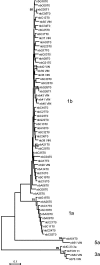Molecular epidemiology of a hepatitis C virus outbreak in a hemodialysis unit
- PMID: 15956393
- PMCID: PMC1151931
- DOI: 10.1128/JCM.43.6.2750-2755.2005
Molecular epidemiology of a hepatitis C virus outbreak in a hemodialysis unit
Abstract
We analyzed a hepatitis C virus (HCV) transmission case in the hemodialysis unit of a private clinic by sequencing two genome regions of virus isolates from a number of patients attending this unit and some external controls. The analysis of 337 nucleotides (nt) in the NS5B region did not provide enough resolution to ascertain which patients were actually involved in the outbreak and the potential source. Nevertheless, this region allowed the exclusion of several patients as putative sources of the transmission case based on their genotypes and phylogenetic relationships. On the other hand, the analysis of several 472-nt-long clone sequences per sample in a more rapidly evolving region of the HCV genome, coding for the envelope proteins and encompassing hypervariable region 1, allowed us to establish the existence of at least two independent transmission events involving two different source patients and three recipients. The direction of the transmissions was further corroborated by different measures of genetic variability within and among samples.
Figures



References
-
- Andrews, P. 1992. Evolution and environment in the hominoidea. Nature 360:641-646. - PubMed
-
- Casino, C., J. McAllister, F. Davidson, J. Power, E. Lawlor, P. L. Yap, P. Simmonds, and D. B. Smith. 1999. Variation of hepatitis C virus following serial transmission: multiple mechanisms of diversification of the hypervariable region and evidence for convergent genome evolution. J. Gen. Virol. 80:717-725. - PubMed
-
- Echevarria, J. M., P. León, C. J. Domingo, J. A. López, C. Elola, M. Madurga, F. Salmerón, P. L. Yap, J. Daub, and P. Simmonds. 1996. Laboratory diagnosis and molecular epidemiology of an outbreak of hepatitis C virus infection among recipients of human intravenous immunoglobulin in Spain. Transfusion 36:725-730. - PubMed
-
- Esteban, J. I., J. Gómez, M. Martell, B. Cabot, J. Quer, J. Camps, A. González, T. Otero, A. Moya, R. Esteban, and J. Guardia. 1996. Transmission of hepatitis C virus by a cardiac surgeon. N. Engl. J. Med. 334:555-560. - PubMed
-
- Felsenstein, J. 1985. Confidence limits on phylogenies: an approach using the bootstrap. Evolution 39:783-791. - PubMed
Publication types
MeSH terms
Substances
Associated data
- Actions
- Actions
- Actions
- Actions
- Actions
- Actions
- Actions
- Actions
- Actions
- Actions
- Actions
- Actions
- Actions
- Actions
- Actions
- Actions
- Actions
- Actions
- Actions
- Actions
- Actions
- Actions
- Actions
- Actions
- Actions
- Actions
- Actions
- Actions
- Actions
- Actions
- Actions
- Actions
- Actions
- Actions
- Actions
- Actions
- Actions
- Actions
- Actions
- Actions
- Actions
- Actions
- Actions
- Actions
- Actions
- Actions
- Actions
- Actions
- Actions
- Actions
- Actions
- Actions
- Actions
- Actions
- Actions
- Actions
- Actions
- Actions
- Actions
- Actions
- Actions
- Actions
- Actions
- Actions
- Actions
- Actions
- Actions
- Actions
- Actions
- Actions
- Actions
- Actions
- Actions
- Actions
- Actions
- Actions
- Actions
- Actions
- Actions
- Actions
- Actions
- Actions
- Actions
- Actions
- Actions
- Actions
- Actions
- Actions
- Actions
- Actions
- Actions
- Actions
- Actions
- Actions
- Actions
- Actions
- Actions
- Actions
- Actions
- Actions
- Actions
- Actions
- Actions
- Actions
- Actions
- Actions
- Actions
- Actions
- Actions
- Actions
- Actions
- Actions
- Actions
- Actions
- Actions
- Actions
- Actions
- Actions
- Actions
- Actions
- Actions
- Actions
- Actions
- Actions
- Actions
- Actions
- Actions
- Actions
- Actions
- Actions
- Actions
- Actions
- Actions
- Actions
- Actions
- Actions
- Actions
- Actions
- Actions
- Actions
- Actions
- Actions
- Actions
- Actions
- Actions
- Actions
- Actions
- Actions
- Actions
- Actions
- Actions
- Actions
- Actions
- Actions
- Actions
- Actions
- Actions
- Actions
- Actions
- Actions
- Actions
- Actions
- Actions
- Actions
- Actions
- Actions
- Actions
- Actions
- Actions
- Actions
- Actions
- Actions
- Actions
- Actions
- Actions
- Actions
- Actions
- Actions
- Actions
- Actions
- Actions
- Actions
- Actions
- Actions
- Actions
- Actions
- Actions
- Actions
- Actions
- Actions
- Actions
- Actions
- Actions
- Actions
- Actions
- Actions
- Actions
- Actions
- Actions
- Actions
- Actions
- Actions
- Actions
- Actions
- Actions
- Actions
- Actions
- Actions
- Actions
- Actions
- Actions
- Actions
- Actions
LinkOut - more resources
Full Text Sources
Medical
Molecular Biology Databases
Research Materials

